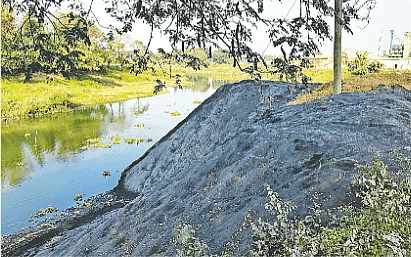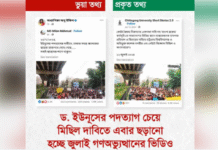
1
There are reports that river Bangshi in Dhaka being is smothered to death with ashes. Earlier it was reported that the Fulbaria-Nayarhat part of the Bangshi river has been forcefully occupied and filled. Thousands of illegal structures have sprung up on the banks of the river. The district administration has prepared eviction documents, but none of the concerned officials are taking any action. The rice mills that have sprung up along the banks of the river are dumping tons of ashes every day near Kelia Mor (Hirarbagh) along the Dhamrai stretch of the Bangshi.
Proceeding from Dhamrai’s Aingon towards Kalampur, the river is almost strangled at the Kelia Mor (where the river turns towards Sombhag). And it’s the same situation gradually developing under the Sharifbagh Bridge in Dhamrai. The local river-loving people have sent pictures of the dying river to the authorities.
Machimpur Ghat, Kalighat, Jhalopara, Kadamtali, Chandnighat, Topkhanaghat, Kazirbazar, Sheikhghat and Kanishail ghat of Mehndibagh area of Surma river flowing through the heart of Sylhet city, are being increasingly polluted. In some places, the traders are throwing rotten fruits, vegetables, fish and leftover garbage into or near the river. Latrines have been built and connected to the river. As a result, human excretion also mixes with the river water. Even after trying to beautify the Narsunda river of Kishoreganj by spending billions, it is turning into a garbage dump again.
3
Some people want the river to be a reservoir of fish, some people want navigable waterways, some want affordable commute, some people see the river as a sand mine. Some even think, what is the benefit of allowing so much water just to flow into the sea? They prefer to use the water for irrigation factories and to drink. What is the harm in using river water?
But what is the benefit of keeping the river if it cannot meet the needs of irrigation, defecation and thirst? If nothing, what is the harm in turning it into a garbage dump?
All said and done, it is encouraging that there is no shortage of people to protect the rivers. Recently, due to the continuous efforts of such people, Halda river has been declared as the ‘Bangabandhu Fisheries Heritage’ through a gazette notification. Whether the ministry has taken such a step out of love for main architect of the nation or out of helplessness, is another matter. But the bottom line is, even after all these steps, the tug-of-war with the Halda river continues.
It has not been long that the gazette was issued, yet already the minister of the Local Government, Rural Development and Cooperatives (LGRD) ministry has said that there will be no harm in extracting water from the Halda river for the Mirsarai economic zone.
The minister went to Chattogram to hand over the street lights donated by China to the city officials there. He said that extracting water from the river would not harm the breeding grounds of the fish.
Referring to the calculations given by his water bureaucrats, he said that 360 cusecs of water flow in the Halda river every second. If you take only 3.6 cusecs of water from there, there will be no problem in the water flow.
The minister further said that the breeding season of the fish in Halda river stretches from April-June. At that time the flow of water is much higher than normal. The water flow gradually reduces during the dry season. But there is no harm even in extracting river water in the dry season too, as the fish do not breed at this time. He spoke as if the Halda river was just a maternity center of the fish, just giving a little water while laying eggs will be enough.
The mother fish start to roam in the Halda river long before laying eggs. Ainun Nishat, former vice-chancellor of BRAC University and a prominent water expert in the country, said mother fish come to Halda long before the monsoon. If the environment is not conducive, there will be no trace of eggs despite the heavy water flow in the monsoon.
After the first rains in Chaitra-Baishakh (mid-April to mid-May), the wetlands connected to the Halda get flooded and a lot of organic components merge with the river water. As a result, the river becomes the source of adequate food. This is how the pre-breeding environment matures. And the water carrying soil from the hill springs, is highly enriched with a lot of macro and micronutrients. As a result, pre-monsoon rains create enough food particles in the river.

4
This round-the-year process is part and parcel of creating a favorable environment for fish in the Halda River. The bends of the Halda River are called the Oxbow bends. The main feature is that it creates strong vortexes, which create deep holes. Locally these deep spaces are wells. Various nutrients and other substances from upstream accumulate in these wells. As a result, the water becomes very turbid. The mother fish take shelter in this turbid water and lay eggs. The hill springs or stream, the presence of one or more bils (wetlands) upstream, the depth of the river, low temperatures, strong currents, very turbid water – none of these can be obstructed. If these are disturbed or obstructed, the fish will not be interested in laying eggs in the resulting inappropriate environment. Therefore, considering all aspects, clear instructions have been given in the gazette to the effect that water cannot be extracted by setting up a new water treatment plant or an irrigation project in the Halda river without the permission of Bangabandhu Fisheries Heritage Supervision Committee. Motorised boats are barred from operating before and during the breeding season to protect the pre-breeding movement of the fish.
5
Halda emerges from Batnatali hills of Khagrachhari and entered into Chattogram district via Fatikchhari. It then flows southeast and then southwards, passing through Bibirhat, Nazirhat, Sattarghat and other parts of Fatikchhari, Hathazari, Raozan and Chandgaon-Baklia area in the Chattagram city and merges with the Karnafuli river near Kalurghat.
The river flows 85km from Khagrachhari to meet Karnafuli. The entire 85km waterway use to be suitable for navigating any kind of boat throughout the year. Now only 29km of this vast waterway remains suitable for large boats throughout the year.
Despite being the victim of so much mistreatment, negligence and wrong decisions, Halda is our only river where the genetic stock of the rui species (carp) of fish remains unaltered. It is difficult to find another river like Halda elsewhere in the world, where the tides are constant, but the carp species lay eggs and the fertilised eggs are collected. For all these reasons, the Halda river is not only a natural fish breeding heritage of the country, but an unparalleled heritage of Mother Earth.
If there had not been so much looting and corruption, UNESCO might have declared this as a world heritage site by now.
About 420 million litres of water are extracted from Halda every day to meet the demand of Chittagong city and irrigation alone. If the new project proposed by the minister is implemented, the amount of water extracted per day will be 560 million litres. If this amount of water is extracted daily, one-third of the water of the Halda river will vanish in the dry season. As a result, Halda will lose its originality. One of the unique breeding grounds of fish will be destroyed.
But that does not mean, we have to meet these demands by emptying the Halda river, which is 60km away from the economic zone.
When asked about this, Manzoorul Kibria, an expert on the Halda river, said that there are many more water sources, including the Feni river and the Muhuri project next to the Mirsarai industrial city. If the water is extracted from those nearby sources, the cost of the project implementation will be much less. Why extract water from a source 60km far from Mirsarai excluding the nearer ones? This will increase the expenditure of the project. The Halda river will suffer too.
According to him, if extracting water from the river is a must, then the Karnafuli river is a much better option than Halda.
Prof Ainun Nishat thinks that the demand for water can be easily met by constructing a reservoir in the form of Foy’s Lake. There is an opportunity to build such an installation near Mirsarai on an ecological basis.
It should not be forgotten that the officials of the Chattogram Water Supply & Sewerage Authority (WASA) are working on the paperwork to justify the plan to extract more water from Halda for the industrial zone. To that end, they awarded a contract to the Institute of Water Modeling (IWM), an agency under the Ministry of Water Resources, to explore the feasibility of their dream. The IWM has already submitted a report according to the wishes of their clients
6
It should also not be forgotten that saltwater has been entering the Halda river for several years. To deal with the situation, many have suggested that two or three gates of the Kaptai Dam should be left open in the dry season during high tide. Attempts have also been made as per this proposal. The results of these efforts, including all the data, should be made public, with transparency. Whether or not the people have the right to know, surely the rivers and reservoirs have a right to know whether Kaptai will be able save its water for survival or will be the victim of over-ambitious plans. The river is now recognised as a living entity. It is important to get its opinion on all the concerning decisions. To meet the sea is the birthright of the river. Depriving it of this right is equal to committing a massacre. Is it right to instigate murder?
Let the rivers live like rivers.
Gawher Nayeem Wahra is an author and researcher and can be contacted at nayeem5508@gmail.com
This article appeared in the print and online edition of Prothom Alo and has been rewritten for the English edition by Ashish Basu









